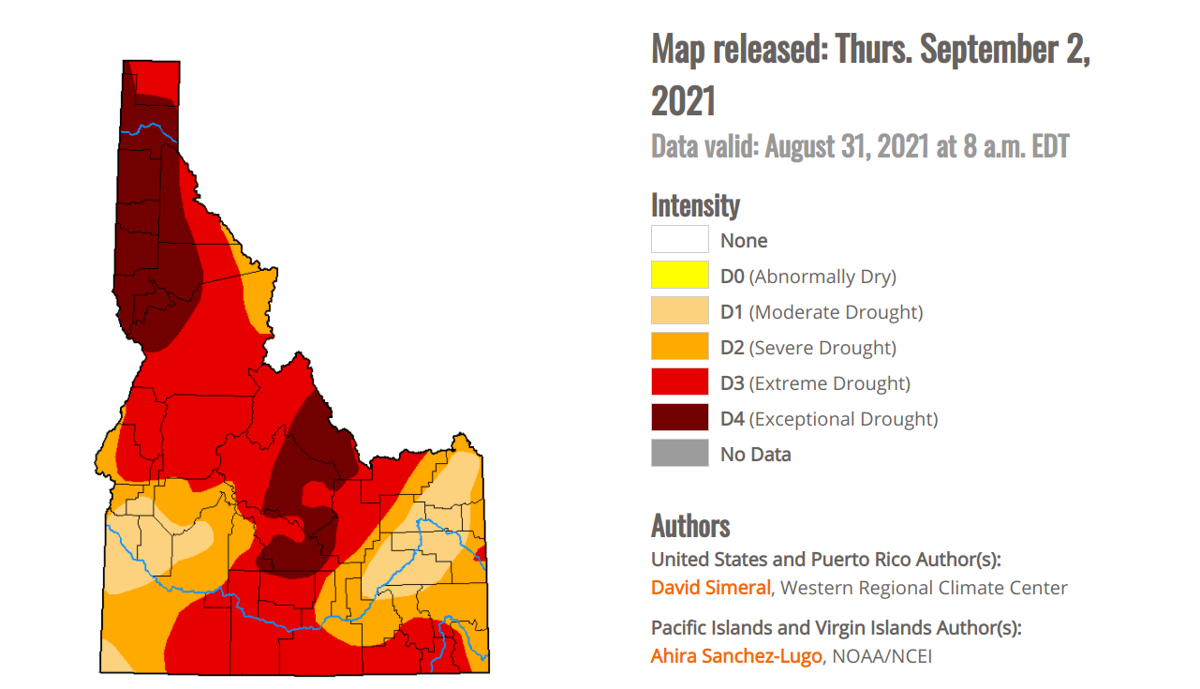“The impacts that they’re facing right now (in the Southwest) is our future,” Sadegh said. “Because they are downstream, a lot of the upstream (water users) are taking the water, so there’s not enough water that is delivered.”

The U.S. Drought Monitor is jointly produced by the National Drought Mitigation Center at the University of Nebraska-Lincoln, the United States Department of Agriculture, and the National Oceanic and Atmospheric Administration. Map courtesy of NDMC.
Food and Other Risks
“The cost of food, as you can see this year, has been higher than previous years because of the drought,” Sadegh said. “If this continues, then we will be worried about food security.”
Now, the state is in a position where all it can do is hope next year is wetter. There are some longer-term moves farmers can make, such as potentially changing the crops they grow. For example, corn and potatoes are water-intensive.
Brittany Brand, the director for the Boise State Hazard and Climate Resilience Institute and a Department of Geosciences associate professor, agreed. Living with less water may mean changes to agricultural practices, such as growing crops that require less water or shifting growing seasons, she said.
“We need food and we need water,” Brand said. “So with respect to agriculture, potentially changing agriculture practices to be more sustainable, (so we can) use less water and still turn a significant profit, and also produce significant food.”
Most Idaho droughts are snow droughts when there isn’t adequate snowpack and farmers can often prepare in advance, she said. But this year was unexpected. The snowpack should have been adequate, but the problem was an extremely dry spring followed by extreme heat.
“The concern we have is that if we don’t have really strong snowpack this winter, as in much greater than normal snowpack, than we might be in for a multiyear drought,” Brand said. “If we have even an average snow year, it’s not going to be sufficient to refill our reservoirs as much as we need them to be filled.”
The Treasure Valley is in a moderate drought, which also brings with it an increased risk for fire. Fires spread easily in a moderate drought, according to the University of Nebraska — Lincoln drought monitor.
Wildfire smoke is a concern for Scotty Miller, a Nampa farmer. Miller grows a variety of crops, including seed crops such as beans and carrots, as well as sugar beets and spearmint. Miller says his bean crop struggles in smoky conditions.
“We have a hard time getting them to dry out,” Miller said, referencing the process of drying the beans after harvest, “and when the sun isn’t shining, the plants don’t get enough photosynthesis,” he said, which affects the quantity of the beans each plant produces.
Other important Idaho crops can be affected by smoke and drought. Exposure to smoke can change the taste and sugar content of wine grapes. However, the smoke usually has to come from a fire that is close by, said Sean Ellis, publications editor for the Idaho Farm Bureau.
Most of the wineries in the Sunnyslope area of Canyon County use irrigation water, helping offset the drought’s effects.
“We are lucky to have not experienced any drought issues in our vineyards at Ste. Chapelle and Sawtooth (vineyards),” said Brad Mayer, spokesperson for the wineries.
Potatoes, on the other hand, are a water-intensive crop that can be sensitive to heat and variation in precipitation. Most are grown in the eastern part of the state, but some are grown in the Treasure Valley. Potato farmers have done test digs ahead of the state’s fall harvest to catch a preview of the crop, and it’s not looking great — potatoes are smaller than they should be at this point in the summer, or there are fewer potatoes than expected, Ellis said. Though the crop has some time to bulk up before harvest, it isn’t heartening, Ellis said.
Forty-two of Idaho’s 44 counties grow wheat, and wheat farmers too have seen poor germination and expect to see poor yields this year due to drought, Ellis said.
So, how are people in agriculture thinking about a drier future? Hipwell, the rancher, does not think of the changes she is witnessing in terms of climate change, per se.
“In what we do, weather is always a factor,” she said, saying there are Earth cycles that they can recognize and respond to. “We don’t put much thought into putting a name on it. We just try to prepare for what we’re in and what might be coming. That’s just the nature of our business.”
For Wilder, of the Wool Growers Association, thinking about the environment she works in is a top priority.
“We rely on the land to do what we do,” Wilder said, “and so we are the best stewards of the land because we care so much about it.” In addition to thinking about what the weather will be like in the future, producers in her industry are also interested in maximizing the efficiency and sustainability of their practices.
“When we talk about climate change and this world we live in, agriculture has a place at the table, and we’re constantly working toward creating a better future and working toward using the resources we’re given in stewarding the land in the best way possible.”